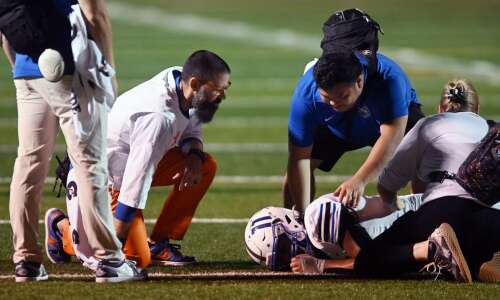When the Buffalo Bills’ Damar Hamlin suffered cardiac arrest and nearly died during a nationally televised NFL game on Jan. 2, 2023, it put the risks of playing football in the spotlight.
Hamlin is back on the field. But since this year’s high school football season began, news accounts have reported a rash of player deaths across the country, whether directly through traumatic injury or indirectly through events such as cardiac arrest and heatstroke.
Karissa Niehoff, CEO of the National Federation of State High School Associations, said the organization has counted 12 deaths so far this season. Their data comes from the National Center for Catastrophic Sport Injury Research, which uses reports from NFHS-member schools as well as private schools outside its membership.
NCCSIR reported 16 deaths in 2023 — five college players, seven in high school and two each in middle school and youth football.
“Obviously it’s something to be concerned about,” Niehoff said, but noted that the numbers are well below where they were decades ago. In 1968, she said, there were 36 deaths reported in high school football.
“We started to pay attention, and through coaching education we modified rules, we shifted how we practice and how we play, and obviously elevated our medical response, resources and awareness,” Niehoff said.
“The sport of tackle football right now — you hate to use the word, ‘safe,’ because it’s football, and it’s sports — but it’s probably the safest it’s ever been.”
In August, the Indianapolis-based NFHS reported that 1,031,508 high school boys played 11-man football last school year, making it the most popular prep sport in the nation. Another 26,420 played 8-man football.
The recent deaths have led to sympathy but not alarm among those looking after players in the suburbs.
“Obviously, all these deaths are tragedies,” said Greg Garofalo, athletic trainer at Hoffman Estates High School. “I think one of the things that we should focus on, what was the preparation like for these schools?”
Garofalo, president of the Illinois Athletic Trainers Association, said that while he’s treated plenty of serious injuries, he hasn’t had to treat any catastrophic or life-threatening situations in his 10 years as a trainer, including nine at Hoffman Estates.
St. Francis High School head athletic trainer Sarah Anderson, a 23-year veteran, said she and her colleagues undergo continuing education to keep up with the best practices.
“Any time you have any activity that the human body is being tested, sometimes whether it’s genetics or whether something is not working right with that person, we’re just hopefully equipped and trained to help them if something severe happens,” she said.
Under Illinois High School Association mandate, all coaches, including assistants, must be trained in first aid, CPR and the use of automated external defibrillators (AEDs).
Niehoff said the NFHS has provided both AEDs and wet bulb globe thermometers — which monitor heat stress — to all 51 state athletic associations, including Washington, D.C.
“I will say, for Illinois, they are one of the states in the country that is the most educated and the most proactive when it comes to keeping kids safe, emergency action plans, whatever resources need to be put into schools,” Niehoff said.
“So, a shoutout to (IHSA Executive Director) Craig Anderson and the Illinois High School Association. Even their elementary school association (IESA), they are leading the country in a lot of ways,” she added.
Garofalo said the two key aspects of treatment at the high school level are simply having action plans in place and an athletic trainer as part of the program.
“Having a venue-specific emergency action plan is probably the biggest thing you can do,” he said.
While some athletes continue to “tough it out” while experiencing an injury or discomfort, more are now willing to come forward, he added.
Garofalo also stated the importance of cardiac screenings that might catch previously undiagnosed abnormalities and, particularly, collecting a player’s detailed family medical history.
A 2012 study of the Journal of the American Board of Family Medicine said 72% of students who suffered from sudden cardiac arrest were reported to have experienced at least one symptom prior to the incident by their parents, but it wasn’t seen as life threatening.
Dr. Marc Hilgers, a sports medicine physician and concussion specialist at Advocate Heath Care and football team doctor for West Aurora High School, noted that the U.S. Centers for Disease Control and Prevention issued recommendations in June on actions to reduce head impacts in youth football.
The statement, specifying players ages 6-14, suggested more opportunities to play noncontact football, reduced contact practices, strictly enforcing penalties for head-to-head contact, teaching age-appropriate blocking and tackling skills, and impact prevention education.
“Flag football has become more and more popular especially in light of the complications we’ve had in head injuries,” Hilgers said.
But he also noted less reliance on contact drills and greater emphasis on safe technique brought about by more informed coaches, as well as rules changes to protect athletes.
Hilgers doesn’t believe this year’s fatalities mean there’s a greater risk to playing football.
“If you extrapolate it, I wouldn’t think it’s a significant difference from prior years,” he said.
The deaths, though tragic, are a very rare, officials say.
“The coaches were doing the right things, the schools had the right resources in place, they had emergency action plans that were executed. It’s just extremely unfortunate,” Niehoff said.
Hoffman Estates firefighter/paramedics arrive to staff the varsity football game between Maine East and Hoffman Estates high schools on Friday, Sept. 13 in Hoffman Estates. Having paramedics on standby is among the measures high schools take to address player safety.
Joe Lewnard/jlewnard@dailyherald.com
Hoffman Estates High School athletic trainer Greg Garofalo tapes senior Anthony Elenz prior to a football game against Maine East High School on Sept. 13.
Joe Lewnard/jlewnard@dailyherald.com
Trainer Megan Hutchins stretches the hamstring of Libertyville High School quarterback Quinn Schambow on the sidelines during a Sept. 13 game against Stevenson High School in Lincolnshire.
John Starks/jstarks@dailyherald.com
